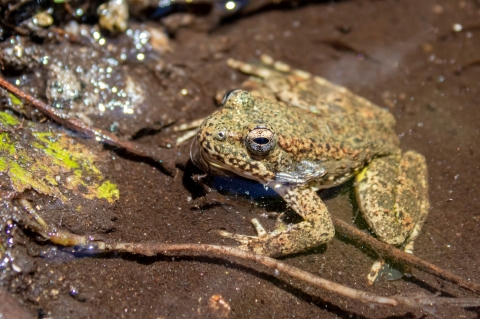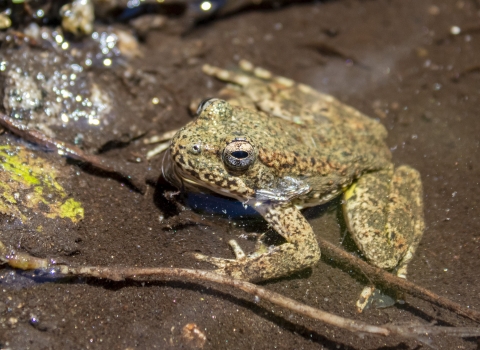Sacramento, Calif. - The U.S. Fish and Wildlife Service is seeking public comment on a proposal to designate 760,071 acres of critical habitat for the four listed distinct populations segments of foothill yellow-legged frog in California that are essential to conservation of the species.
The Service is proposing to designate 192,275 acres of critical habitat for the North Feather population (threatened), 307,777 acres for the South Sierra population (endangered), 249,942 acres for the Central Coast population (threatened) and 10,077 acres for the South Coast population (endangered).
The foothill yellow-legged frog, named for its yellow belly and underside of its rear legs, is found from Oregon to Southern California. Historical declines of the listed populations were due to mining and altered hydrology related to the development of California’s extensive water infrastructure network. Today, the species faces multiple threats, including altered waterflows related to water infrastructure such as dams and diversions, competition with and predation by non-native species such as bullfrogs and crayfish, disease, precipitation and temperature changes related to climate change climate change
Climate change includes both global warming driven by human-induced emissions of greenhouse gases and the resulting large-scale shifts in weather patterns. Though there have been previous periods of climatic change, since the mid-20th century humans have had an unprecedented impact on Earth's climate system and caused change on a global scale.
Learn more about climate change , high-severity wildfires, water-related recreation, and habitat conversion and degradation.
“Our goal is to help the foothill yellow-legged frog recover across its range,” said Michael Fris, field supervisor of the Sacramento Fish and Wildlife Office. “Establishing critical habitat is one step we can take to support the amphibian’s recovery.”
The Service used the best available science to identify only those areas that are essential to the conservation of the species. The proposed critical habitat includes land along streams and other water bodies inhabited by the foothill yellow-legged frog, as well as nearby upland areas that are used by the amphibian for dispersal and shelter. Approximately half of the proposed critical habitat falls on federal lands managed by the U.S. Forest Service, U.S. Bureau of Land Management and U.S. Bureau of Reclamation. These agencies have plans in place that help minimize the impacts of their land management activities on the frog.
The Service is working with partners to address and minimize the impact of the amphibian’s listing and proposed critical habitat on communities and public lands while achieving the best conservation outcomes. The Service included a 4(d) rule for the North Feather and Central Coast populations that provides an exception from prohibition of take under the Endangered Species Act for forest fuels management activities that reduce the risk of catastrophic wildfires. These fires destroy wildlife habitat and threaten communities and infrastructure. The Service will also continue to work with reservoir operators to consider the needs of the frog, especially during the breeding season.
“Establishing critical habitat is not intended to interfere with the operations of California’s extensive water infrastructure or essential activities that reduce the risk of large-scale high-severity wildfire,” said Fris.
The designation of critical habitat would not affect land ownership or establish a wildlife refuge, wilderness reserve, preserve or other conservation area conservation area
A conservation area or wildlife management area is a type of national wildlife refuge that consists primarily or entirely of conservation easements on private lands. These conservation easements support private landowner efforts to protect important habitat for fish and wildlife. There are 15 conservation areas and nine wildlife management areas in the National Wildlife Refuge System.
Learn more about conservation area . Private landowners only need to consider critical habitat if their activities involve federal funding or permitting.
Several efforts are already underway to help recover the frog. The Service worked closely with partners at the Oakland Zoo, U.S. Forest Service, Garcia and Associates, Pacific Gas and Electric Company and California Department of Fish and Wildlife to raise foothill yellow-legged frogs in captivity and release them into Plumas National Forest. To date, more than 250 frogs have been released into the forest as part of this effort. Additionally, the frog is included in three habitat conservation plans that are being implemented in California, the East Contra Costa Habitat Conservation Plan, Placer County Conservation Program and Santa Clara Valley Habitat Conservation Plan.
A copy of the proposed rule will publish in the Federal Register on January 14, 2025, and can be found in the Reading Room today. The public can review the proposed critical habitat and provide public comment starting January 14, 2025, at www.regulations.gov by searching Docket Number FWS-R8-ES-2023-0157. The comment period will close March 17, 2025.







